Text


Saying hello to Circe again after a long time without working with her. Made her a cup of mugwort tea with honey, painted a pig skull for her, and presented her with a cute little pig incense holder.
#Circe#offering#witchcraft#hellenism#my goal is monster transformation in lucid dreams#and wouldn’t you know it animal and monster transformation is one of her things#pretty much the main reason for me getting into witchcraft is transformation in whatever way possible
0 notes
Text
Offerings to Circe

Who is Circe?
Circe is a goddess of sorcery, necromancy, transmutation, illusion and most importantly the practicalities of witchcraft. She is a very skilled herbalist, able to create potent potions, narcotics etc and has a deep connection with wild animals and is able to live with them as if they are tame.
Circe respects hard work and dedication, she learned her skills as a human, which sets her far apart from most deities, but makes her an ideal goddess to work with for human witches of any path, background, or culture.
Offerings
- Any working herbs, dried, fresh etc
- Notes, study, writings of your own
- Pigs, anything pig themed
- Acts of gathering, solo work in the woods etc
- Wine
- Wands and staves
- Poisonous or stinging plants
- Gathered objects
Beware - Circe is easy to start communication with if you are serious about learning her arts, but easily displeased if you aren’t serious or dedicated. She’s well known for being incredibly powerful, and not necessarily easily offended, but very aware of your intentions. She will prefer people who have a dedicated space for her, or a dedicated space to learn her crafts
147 notes
·
View notes
Text
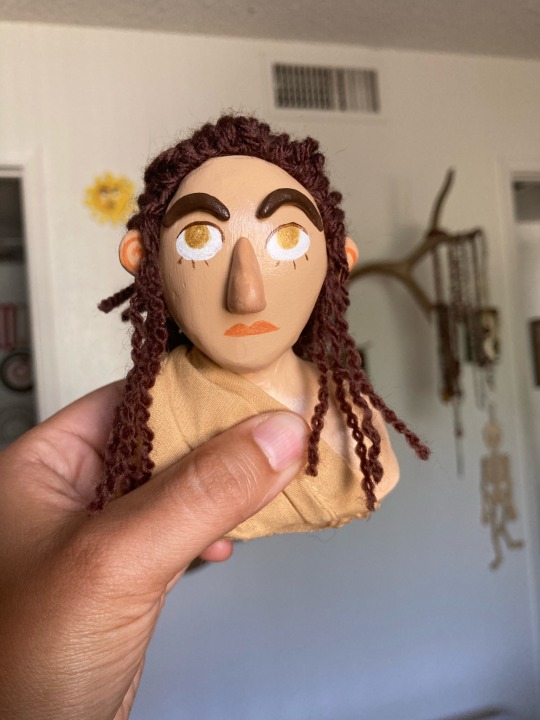



Hey! I finished the Circe bust! Made from tin foil, polymer clay, yarn, acrylics, and a little piece of my sheet! I’m pretty happy with how it came out, the dark brown hair and strong brows are the main things I remember from that flash of an image of her that came to me in a dream. I’ll do some sort of Thing I guess before I officially place it in the altar. I’ll make it up as I go along. I plan on using it for rituals and stuff.
#circe#witchcraft#altar#witchblr#hellenism#greek paganism#beginner witch#it was such a pain sanding it down but love the result
32 notes
·
View notes
Text
One more for #NationalPigDay:

Paul Manship (American, 1885-1966), Circe Enchants Ulysses' Sailors, 1957, bronze on wood base, 5 1⁄2 x 6 1⁄2 in. (14.0 x 16.5 cm) diameter. Smithsonian American Art Museum.
"Paul Manship created many sculptures of mythical characters and often chose to illustrate a particular moment in a legend rather than a general theme or symbol. This sculpture shows a scene from the story of Ulysses, a Greek leader in the Trojan War. When Ulysses and his men stopped at an island in search of food, the sorceress Circe captured the crew and turned them into pigs. Ulysses saved his men with the help of a special herb that countered Circe’s magic. Manship chose not to show the hero Ulysses and instead depicted Circe surrounded by the enslaved sailors."
50 notes
·
View notes
Text
Some witch: * fills a glass jar with crystals, herbs, salt, and glitter, then chucks it in a bush in their local park *
The jar: * breaks *
The salt and glitter: * spills into the soil *
The soil: * becomes infertile *
Plant: * dies *
Some animal: * gets hurt on the broken glass *
Another animal: *chokes on the lid ring *
The nature spirits: "what the actual fuck"
The witch: "why isnt my spell working :(((("
4K notes
·
View notes
Text
I feel like people these days put too much value in physical offerings. Like, yeah some food and whiskey makes good offerings... But have you considered offering your time? Actions make just as good offerings. Like, you could learn a new hobby in honor of your ancestors because they themselves liked that hobby too. You could learn to play an instrument for them. You could literally just nod your head at their altar in acknowledgement. Time has just as much value as physical offerings.
1K notes
·
View notes
Text
Whoa there, pardner! What have you done to make sure that belief or practice actually originates in ancient times and didn't come from the imagination of a repressed Victorian romantic?
18K notes
·
View notes
Text
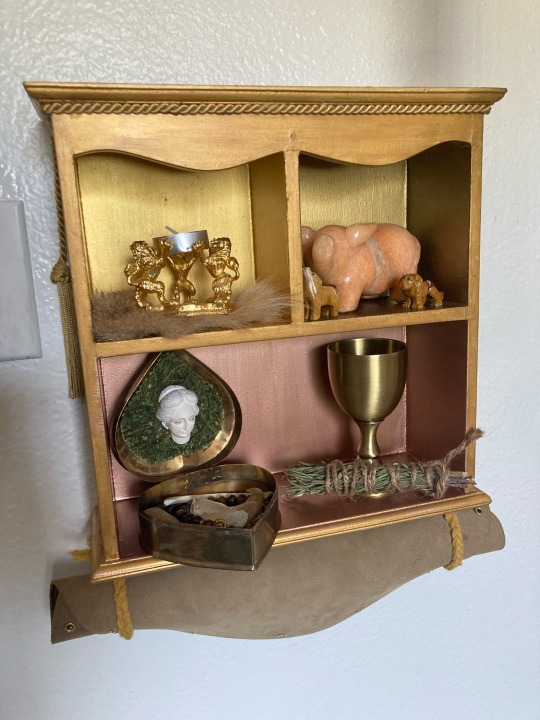
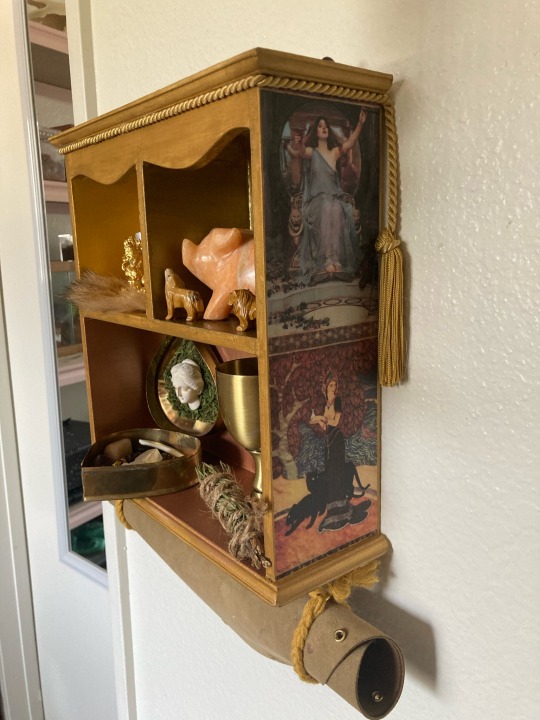

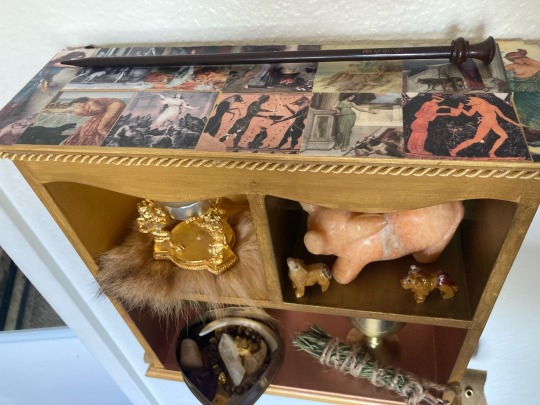
I finally put my altar up for Circe and got the go ahead to share it! I am very proud of it! I decoupaged a thrift store find with images of her, painted the insides with four shades of gold, added a tassel, and rigged up hooks on the bottom to hang the pig suede altar cloth using yarn I braided (braids are one of her things). I am especially happy to have been able to source a piece of old European wolf pelt from a friend! The lion candle holder was a cool find, and I already had that massive sunstone pig carving that fits nicely. I’ll probably add more to it and swap some things around occasionally, but it came out how I hoped it would! More importantly, it got her stamp of approval c:
#witchblr#circe#altar#beginner witch#hellenism#greek paganism#personal post#animal remains are very important to me/my practice#there is a broken piece of pig tusk along with the pig suede#I have a broken pig skull I’ll eventually figure out how to decorate for her#obviously lion parts are a no but I had a ‘panther’ claw which still feels appropriate#the ‘wand’ is a defective knitting needle I had#I might spruce it up but honestly like how simple it is
30 notes
·
View notes
Note
How would you recommend starting to make my own custom spells and chants? I've never made my own spell before. I'm also a beginner and nervous around fire. Is it possible to cast many spells without fire or lighting candles, etc?
Hey there! With custom spells I would suggest looking into what type of spell you would like to do (e.g. Spell jar, witches ladder, knot spell, petitions, sigils etc.) or even colour correspondences. If you would like a to make a jar spell I would recommend looking up a list of herbs, oils, salts, and crystals if you wish to use any and seeing which ones fit your need/wish the best. Definitely cross check and look up different options for whatever you choose to use if you do wish to make a spell jar. Here's a list from Pinterest I found but again, I would definitely say do some looking and research to see what fits and suits your needs the best.
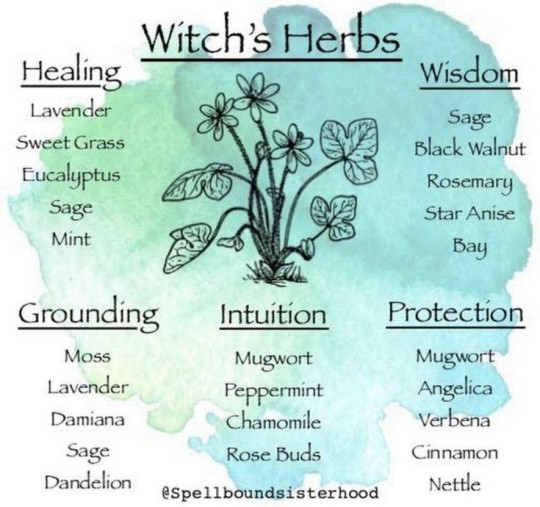
For knot spells/witch's ladder (some people consider them to be the same and others don't but in my opinion they are similar) you'll need a piece of string and there are various tutorials on YouTube, Pinterest and I believe on here too (I'm not giving you a specific chant/way of doing it for you because it can vary and again, do what suits you best).
For sigils there are premade ones, there are sigil generators where it will generate one for you, or you can create your own.
With petitions you'll need a pen and paper and there are tutorials on how to create them.
Colour correspondences are cool and if you haven't already, I would suggest you check them out. They can be really helpful and quick if you want to match your intention to your day (e.g. If you want protection for say going out, wear black)
Regarding chants, I'm afraid I'm not too sure or well versed in them so I can't help with that aspect I'm afraid.
It's absolutely possible to cast without fire and I'm pretty nervous around it too. I know it can seem daunting at times (and in the future if you do decide to burn or melt things or utilise fire please be careful and practise fire safety) but do what feels the most comfortable to you.
I hope this helped, sorry I couldn't be more help with chants but I'm sure there are others who can help more. Hope you're having a good day :)
8 notes
·
View notes
Text
Pharmakeia, Kirke, Divinity, and Mortality
One thing that I love and find intensely interesting about the goddess, nymph, and/or hero Kirke is the fact that she exists in a space between mortal and divine in every portrayal, but is almost never a demigoddess. So I wanted to address and unpack that a bit, because I haven't seen much on it and it deserves attention.
First, Kirke as a very mortal goddess--this is how I'd classify her portrayal in the Odyssey, where she is clearly divine, but described as very reminiscent of a mortal. This is the origin of one of her most famous epithets, "of mortal speech." This is generally viewed as a unique trait of Kirke.
Second, Kirke as a godly mortal. She was sometimes worshipped with hero cultus, with a sacred space of hers being described as a tomb, generally reserved for dead mortal heroes. I don't believe she was ever viewed as fully mortal, but she was at least mortal adjacent, which is significant in and of itself, even if a rarer portrayal.
Generally, pharmakeia (the sorcery she performed, based in herbs) was seen as at least partly a divine power, but also, not fully in the hands of the gods. The theoi do not need herbs and witchcraft to work their wills, but working one's will through herbs and witchcraft must be at least partly based in a non-mortal power.
Kirke, in my opinion, embodies this divide. As the pharmakis goddess of Aiaia, she uses a craft both mortal and divine. The working of herbs for power is not the way of a full god, but using the power of the herbs is not the typical way of a mortal.
For clarity's sake, I am aware I am somewhat echoing arguments against witchcraft and pharmakeia in Hellenic Polytheist spheres, so I'd like to say that I do not believe pharmakeia to be a hubristic practice. Pharmakeia, in the hands of a mortal pharmakis, controls no god. Gods may refuse their aid, spells may fail and be broken. And, actually, this is another aspect of Kirke's story I find so applicable to pharmakeia: Hermes and the herb 'moly.'
Moly is a herb given to Odysseus by Hermes to protect against Kirke's enchantments. The fact that her pharmakeia is resisted with one little plant, and that the plant is given to a hero by a god, is not an accident.
This is a clear example of how pharmakeia may be overpowered by the gods, and some crafty mortals. Hermes prevented the manifestation of her charms completely and utterly. From this it follows that, outside of stories, the theoi may prevent any witchcraft from succeeding without their consent, and most likely do not need the mythic moly to do it.
But Kirke, the mortal-like goddess and divine mortal, does not need the aid of any god but herself to work her magiks. The gods may stop her, but never control her. She is not under the theoi, and she is not divorced from mortals. She holds the powers, the qualities, and the craft of both.
145 notes
·
View notes
Text
WHAT IS SPIRIT WORK?
▬▬▬▬▬▬▬▬▬▬▬▬▬▬▬▬▬▬▬▬▬▬▬▬
spirit work is how it sounds, working with spirits. these spirits can be spirits of plants, people, animals, mythical beings/creatures, familiars, and otherworldly spirits. it is communing with these spirits, building a relationship with them (forming trust) and asking for their aid (be that in protection, spell work, etc).
TYPES OF SPIRITS
▬▬▬▬▬▬▬▬▬▬▬▬▬▬▬▬▬▬▬▬▬▬▬▬
now i should preface this with the types and branching of spirits is vast and wide, and it is dependent on culture, tradition, and religion. i am going to be focusing on animism and the undead spirits, but i will briefly touch on other important/highlighted entities.
: ̗̀➛ plant/flora spirits; spirits that are of trees, plants, flowers, rocks, etc. things found in nature that aren’t mammals or animals. most common/popular examples being nymph spirits.
: ̗̀➛ animal/fauna spirits; spirits of mammals, bugs, birds, and reptiles - spirits of the animal kingdom excluding humans.
: ̗̀➛ house/domestic spirits; house spirits have the potential and possibility to be human, but they can also be non-human. domestic spirits (in rome they’re called domestici lares) are guardians of a household and generally the protectors of the home and even the hearth (depending on mythos and region). a common/popular example being saints.
: ̗̀➛ tutelary spirits; tutelary/guardian spirits are exactly how they sound, they’re guardians. these spirits can be guardians of a specific place (like a temple or holy ground, see Shi lions), graveyards (this can be any spirit but the most famous is a gargoyle), or of a person (like guardian angels, but any spirit could be a guardian, such as gryphs)
: ̗̀➛ human spirits/shades; a human soul can and is defined many ways and varies from person to person and tradition to tradition, but human spirits (aka shades, ghosts, etc) can and do reside in our realm alongside the spirit realm (via transport, normally by liminal spots or the aid of a psychopomp, but some can travel on their own).
: ̗̀➛ vampiric spirits; vampiric spirits are spirits who drain energy in order to survive or gain strength. back in the day they were known to cause sickness, health issues, and low immune systems, etc. most common/well known spirits are vampires/vampyres, succubi/incubi, some umbra/shadow people, and as i like to call them - dream wyrms.
: ̗̀➛ infernus spirits; infernus spirits are those relating to the underworld, this can at times overlap into the demonic, but not all of the demonic are infernus. infernus spirits are mostly those who aid as psychopomps, but they can be the servants and attendants of infernal or chthonic deities.
: ̗̀➛ mythical creature spirits; mythical creatures or legendary beasts are those who are not of this plane and reside in the spiritual world. some can be worked with while some cannot (such as faer folk, a note about faer folk is that it’s best to just leave them alone, or yokai).
: ̗̀➛ familiar spirits; familiars are spirits/entities who are shapeshifters and sometimes called demons who create a pact with a practitioner/witch/mage/etc. in order to aid them in magical practice and even protection.
BASICS OF SPIRIT WORK
▬▬▬▬▬▬▬▬▬▬▬▬▬▬▬▬▬▬▬▬▬▬▬▬
it’s important to know and note the basics of spirit work in order to start spirit work. so here are the foundations of what is needed to know for proper and safe spirit work.
section i. cleansing
let’s firstly begin with what cleansing is and why witches do it. cleansing is a way of forcing negative energy out of an area or person. cleansing is an act that is sort of like a reset button. think of it like showering! you shower because during the day you collected dust, dirt, sweat, etc. and you want to be clean so you take a shower! cleansing is similar, you collect negative energy from weeks of active or inactive craftmenship and even spirits or other entities can latch onto you and your home which then drains your energy. cleansing is needed to keep your space clean and easy to manage energies. it’s important to cleanse yourself, your space and even items. cleansing is important for all magic arguably, but especially spirit work. there are plenty of methods to cleanse, the most popular is smoke (do note it’s important to not smudge smudging is a closed practice to natives and indigenous in north america). but there are other methods such as sound, air/wind, energy work, and water.
section ii. banishing
banishing is also an important skill to have in your back pocket. banishing is is a more forceful means of cleansing. it’s to forcefully remove an entity and less “nice”. banishing can be done in rituals, spells, using fire (writing the name or being down and burning the paper), air (writing the name or being down and tossing it in the wind), earth (writing the name or being down and burying it), water (writing the name down and tossing it in the sea or river, drowning the paper, etc), etc! loads of ways to banish and more i didn’t mention!
section iii. grounding
grounding is an extremely important part of spirit work. grounding keeps you in a stable mindset and energy wise keeps you balanced. ways of grounding can be dancing, shaking your hands and feet, stomping/jumping, meditating, taking a walk, listening to music, etc.
section iv. circle casting/closing
circle casting is important, especially for beginners, it creates a wall and safe zone for yourself and the spirit. one of the easiest ways (physical circles) is to pour a circle of salt around you, candles or crystals at four points (in the position of a pentacle), etc. as far as mental/energy ones, some use their finger or a wand and do a complete circle around them, or, a circle and a pentacle (pentagram). while casting circles some people call upon and evoke deities, angels, the watchers/watch towers, spirit guides, elements, etc. for protection and ensuring safety. some believe you must cast a circle starting north and finish at west, some don’t. no matter where you start the circle you must start and end the circle at the same point, going the opposite direction than what you started with when casting, will close the circle. so if i casted my circle clockwise, i would close it counterclockwise and end at the same point i started with.
section v. further protection
casting a circle isn’t the only method of protection that should be precautioned, there are also the means of protection such as layering warding (which is a lesson in itself). some examples of warding are; energetic wards, spell jars, spell bags, charms, crystals, sigils, and house guardians to name a few. you can also veil during spirit work, but it’s not necessary.
section vi. boundaries
setting boundaries with spirits is super important, especially if they’re staying long term (but even if it’s short term have boundaries!) so say you don’t like it when spirits knock, establish the boundary politely of “i don’t like it when you knock at night or during the day, so please don’t do that.” remember, be polite, but be firm too. and if you want a spirit gone tell them sternly!
section vii. what are vessels?
vessels are what ground spirits and help to stabilize them in our plane, a vessel can be anything too, such as jewelry, dolls, a pen, bones, literally anything. an anchor is similar to a vessel, but an anchor doesn’t “house” the spirit, more so provides it a free range and source of stability. conduits channel the spirits energy, it can be symbols, sigils or other iconography to channel and then utilize a spirits energy. these are all important tools and things to know when it comes to spirit work.
SPIRIT ETIQUETTE
▬▬▬▬▬▬▬▬▬▬▬▬▬▬▬▬▬▬▬▬▬▬▬▬
In General
: ̗̀➛be assertive, but be polite
: ̗̀➛ do not forcefully bind a spirit to an anchor, vessel, or conduit alike
: ̗̀➛ always use consent when it comes to using vessels, anchors, or conduits
: ̗̀➛ ask and negotiate, come to a compromise, have firm boundaries too
: ̗̀➛don’t forget to feed and provide energy for any vampiric or even familiar spirits
: ̗̀➛ make a schedule if you really need to/set reminders on when communication is and isn’t ok
: ̗̀➛ don’t sell, show, or give away spirits
House Spirits
: ̗̀➛ be polite
: ̗̀➛ treat them like you would treat a living breathing human
: ̗̀➛ when entering a house, i normally like to whisper a quiet greeting or even in my mind saying “hello”, “good day”, “good afternoon”, “good morning” etc.
: ̗̀➛ depending on your belief, greet the house guardian
: ̗̀➛ light a candle to them, do divination, learn about them!
Graveyard
: ̗̀➛ don’t take what’s not yours, it’s impolite
: ̗̀➛ have manners, people from all centuries probably reside there
: ̗̀➛ greet & give offerings to the guardian at the front gate (this can be a tree, a specific spirit, animal spirits, etc.)
: ̗̀➛ treat them like they’re people
: ̗̀➛ dont step on the grass (this is respectful to the dead and their families)
Landmarks (i.e. lakes, forest, plains, oceans, etc.)
: ̗̀➛ introduce yourself & say a greeting
: ̗̀➛ spend quality time & respect boundaries
: ̗̀➛ offer things that will benefit them / the area (i.e. water, compost, etc)
: ̗̀➛ don’t be shy to strike up conversation and divination
1K notes
·
View notes
Photo

Eglon van der Neer Circe Punishes Glaucus by Transforming Scylla into a Monster 1695
29 notes
·
View notes
Text
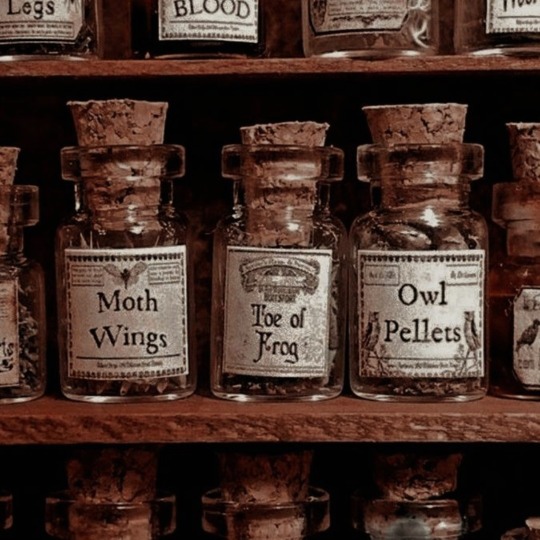


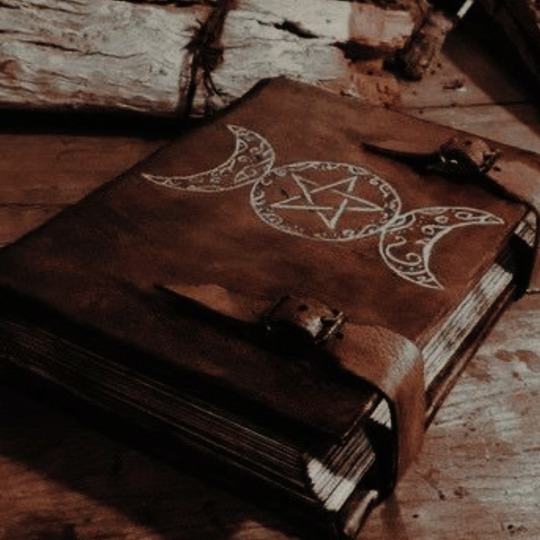





𝖐𝖎𝖗𝖐𝖊 ; 𝖌𝖔𝖉𝖉𝖊𝖘𝖘 𝖔𝖋 𝖘𝖔𝖗𝖈𝖊𝖗𝖞, 𝖒𝖆𝖌𝖎𝖈, 𝖎𝖑𝖑𝖚𝖘𝖎𝖔𝖓🕯🌿
[please reblog or like if you saved]
cr. artists of photos
427 notes
·
View notes
Text
Witchcraft in Hellenismos
Disclaimer: This post is non-exhaustive, and though I'll try to equally spread my focus, it will inevitably lean towards the kinds of magik I personally practice.
Often, in modern pagan circles, people are under the impression that Ancient Hellenismos either didn't have or despised witchcraft. This is largely from three causes. The first is simply misreading, or failing to come across witchcraft in the Hellenism they research. Second is only reading about or adhering to branches that didn't like witchcraft (usually due to it being perceived as hubristic) and therefore assuming that's the most popular opinion. Finally, sometimes people apply their assumptions based on Christian and Germanic culture to Hellenismos, and assume it carries the same attitudes.
In actuality, the view of witchcraft was historically more neutral. Witches weren't typically seen as hags, but maidens, respectable men, priests, and more. It should also be noted that, frankly, "witch" is a slightly tonally incorrect translation usually applied to the word "pharmakis."
For historical attitudes towards witches, we can read works surrounding mainly Medea and Kirke, as well as Hekate if we go past pharmakeia.
But pharmakeia and nekromankia (necromancy) are far from the only forms of witchcraft or magik--which in Ancient Greek would be "mageia" or "goeteia" depending on time and place, but will simply be called "magik" here.
So, with that very long introduction, let's get into types of magik.
Pharmakeia - Herbal Sorcery, Witchcraft
Pharmakeia is perhaps the most recognizable form of magik in historical Hellenismos. As mentioned, it was associated with the heroine Medea, as well as the goddess/nymph/hero (it's complicated) Kirke. This was magik performed using the aid of herbs, and both historically and now blends magik and science. It includes brewing poisons, casting curses, potionmaking, transmutation, and more. Kirke, famously, used pharmakeia to transform men into swine, whereas Medea tended towards poisoning, but both had variety in their craft.
Generally, when pharmakeia is translated, it's done very broadly compared to other kinds of magik. For example, pharmakeia is usually translated, especially in the Odyssey, to "witchcraft" or "sorcery." Pharmakis--the word for a practitioner of pharmakeia--is usually translated to "witch." This often leads to misconceptions of witchcraft in Hellenismos being specifically oriented around herbs and transmutation, when that's only a small piece of the picture.
Nekromankia/Nekromanteia - Necromancy
Nekromankia is far more famous now in its Anglicized pop-culture form, but it was most certainly present in Hellenismos. It's important to clarify that in Ancient Hellas, nekromankia was magik pertaining to the dead, not things such as zombies and raising the dead. In Hellenismos, the maintenance of good relationships between the dead and the living is of great importance. There were plenty of festivals devoted to placating and celebrating the dead--not to mention the monthly Attic holiday Hekate's Deipnon, devoted to honoring Hekate, goddess of nekromankia. So, unsurprisingly, there were witches who gravitated towards this as a craft.
Multiple Hellenic deities were associated with nekromankia, the most notable of which being Hekate, but also Persephone. Though, of course, any khthonic deity--especially khthonic theoi who also had non-khthonic aspects--were relevant, such as Haides or Hermes. A practitioner of nekromankia would be referred to as a nekromanteías.
Manteia - Divination, Oracles
It should be noted that manteia is heavily contested as being a form of witchcraft or even magik in Hellenismos, but it certainly meets the qualifications. The main reason this debate exists is controversy around magik in Hellenismos in general, since as most Hellenists know manteia is so central to so much of our religion, and those who dislike magik are insulted by it being considered that. Additionally, the definition of magik is constantly in flux--it's debated in modern magik circles, and it's even harder to apply a definition we can hardly agree on to an ancient culture with its own independent definitions.
Manteia is, most simply, the power to give prophecies, divination, and the use of oracles. It's the power of the Pythia (Delphic Oracle), it's in the Olympian Alphabet Oracle, it's every single seer and prophecy and divinatory method known to us.
Someone who practices manteia is called a mantis (usually translated as "soothsayer" or "diviner") or a khresmologos ("oracle"), depending on station.
Heliomanteia - Solar Magik
Heliomanteia is hard to find detailed historical information on, but most simply, it's magikal invocation of the sun. This is generally done by attempting to harness the power of the sun, or by requesting the aid of solar deities (namely, Helios).
Interestingly, Helios had many associations with witchcraft and warding off evil. It could be assumed that, due to the qualities attributed to Helios, heliomanteia would be best used to reveal truth, ward off evil, harness the power of fire, promote life, and similar.
Presumably, a practitioner of heliomanteia is a heliomantis.
Goeteia - Magik, Charms
Goeteia (in modern times "goetia") is a term for magik that fell out of style for general magik around the 5th century BC in favor of mageia. It, additionally, was shoehorned into a dichotomy of theurgy (divine, "professional," and virtuous magik) and goeteia (low, malicious, and fraudulent magik). This was largely due to political and social overhaul. The name became associated with fraudulent and harmful magik, and talk of goeteia in Ancient Hellas is a major source most anti-witch Hellenists use.
The goes (practitioner of goetia) was maligned, seen as hubristic and either trying to go against the power of the gods or intending to scam others. Plato famously portrayed them as malicious frauds, and he was not alone. Since the term "goes" is generally translated as "witch," it's not a leap to figure out why this lead to a lot of anti-witch Hellenists.
However, before this (and technically after), "goeteia" simply meant magic, charms, and similar. As a unique practice, and not simply an umbrella term for witchcraft, it can be considered channeling, a relative of nekromankia, or baneful magik, depending how much one leans into the later definition.
Theourgía - Deity Work, Divine Magik
Theourgia (in modern times "theurgy") quite literally translates to "deity work" or "god(s) working." It is ritual, sometimes magik, done with the intent of invoking one or more of the theoi. This was the ritual magik often performed by priests. In fact, it could be considered the mainstream magik of Ancient Hellas--assuming, of course, that one considers it magik.
It's not only historic magik that was central to the religion, but sets historical precedent for the controversial phrase "deity work." The existence of theurgy as the "higher form" of magik in Ancient Hellas is singlehandedly enough evidence to prove the phrase is not and would not be considered inherently hubristic. It should be noted that this form isn't inherently superior, but if you asked Plato, he would disagree.
There are certainly more forms of mageia in Ancient Hellas--For example, I skipped over amulets (periapta), which were almost incontestably the most common magik in a lot of Ancient Hellas, since they could technically fit under some other crafts and because they're the easiest to research on your own. It's a similar case with potions, too.
One important takeaway is the hard line between magik, religion, and science is a fairly recent invention. Pharmakeia could act as medicine, not just sorcery. Many potions were also medication. Frankly, the more women were involved, the more practical it tended to be, with 'spells' often being genuine aids to childbirth and/or birth control. This didn't make them any less magikal, and the magik doesn't make it less real.
And I hope I made it very, very clear, but witchcraft has always been in Hellenismos, and isn't inherently hubristic. That is a myth, and is rooted often in historical (and modern) classism, misogyny, xenophobia, or similar. Always consider your source's incentive to stigmatize before discounting all Hellenic witches.
1K notes
·
View notes
Photo




The Evermore Grimoire: Mythology
Circe (Κιρκη) was an enchantress and goddess of sorcery who was also skilled in the magic of transmutation, illusion, and necromancy in Greek mythology. She lived on the mythical island of Aiaia (Aeaea) with her nymph companions. In Homer’s Odyssey, Circe is described as living in a mansion that stands in the middle of a clearing in a dense wood. Around the house prowled strangely docile lions and wolves, the drugged victims of her magic; they were not dangerous, and fawned on all newcomers. Circe also worked at a huge loom. She invited Odysseus’ crew to a feast of familiar food, a pottage of cheese and meal, sweetened with honey and laced with wine, but also laced with one of her magical potions, and she turned them all into pigs with a wand after they gorged themselves on it. Only Eurylochus, suspecting treachery from the outset, managed to escape to warn Odysseus and the others who had stayed behind at the ships. Odysseus set out to rescue his men, but was intercepted by Hermes (god of trade), who told him to use the holy herb to protect himself from Circe’s potion and, having resisted it, to draw his sword and act as if he were to attack her. From there, Circe would ask him to bed, but Hermes advised caution, for even there the goddess would be treacherous. She would take his manhood unless he had her swear by the names of the gods that she would not.
artwork by Yliade
927 notes
·
View notes

